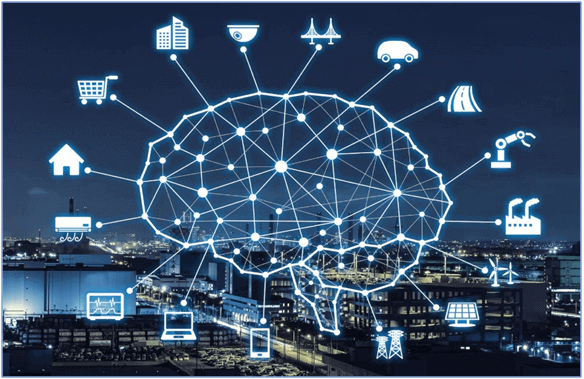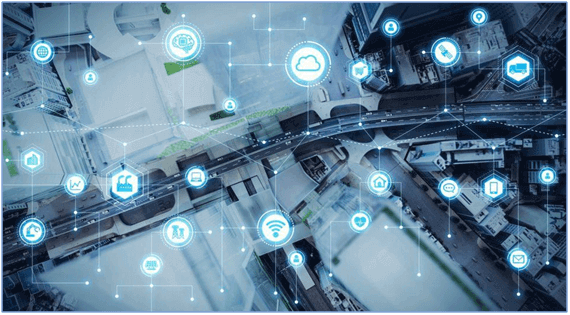Artificial intelligence (AI) promises a brave new world of computers that can plan, strategize, evaluate options, calculate probabilities, and make smart decisions. But to actually do anything, AI needs the Internet of Things (IoT).
You might say that IoT is the body that gives AI’s brain the ability to act. IoT also provides the data AI needs in order to make smart decisions. Just as our eyes, ears, nose, and skin sense the world around us and send that information to the brain to process, billions of sensors and cameras in the Internet of Things gather vast amounts of environmental and operational data to be sorted, analysed and turned into actionable insights by AI. In return, some of these insights and decisions can then be acted upon by IoT and end devices such as robots, drones and industrial machines.

Table of Contents
Internet of Things (IoT) versus Artificial intelligence (AI)
IoT is the internetworking of physical devices which are able to communicate amongst themselves or with the external environment which are ready with gadgets able to speaking over a community. AI is the intelligence displayed by machines, in which, learning and action-based capabilities mimic autonomy rather than process-oriented intelligence.AI is playing a starring role in IoT because of its ability to quickly wring insights from data. Machine learning, an AI technology, brings the ability to automatically identify patterns and detect anomalies in the data that smart sensors and devices generate information such as temperature, pressure, humidity, air quality, vibration, and sound.
Companies are finding that machine learning can have significant advantages over traditional business intelligence tools for analysing IoT data, including being able to make operational predictions up to 20 times earlier and with greater accuracy than threshold-based monitoring systems and other AI technologies such as speech recognition and computer vision can help extract insight from data that used to require human review. The powerful combination of AI and IoT technology is helping companies avoid unplanned downtime, increase operating efficiency, enable new products and services, and enhance risk management.
Integration of AI with IoT
As artificial intelligence (AI) and Internet of Things (IoT) become more commonplace, it is both useful and important to understand how these two important trends work together to benefit specialists and the average person alike. IoT creates a tremendous amount of data. That data can be captured (big data) and analysed. But it is not realistic to do this tracking by human effort, given the sheer volume of data. AI will serve an important role in tracking, going through this mountain of IoT data and distilling it into actionable themes.
Practical Applications in Supply Chain
1. Augmented Real-Time Decision Making
Logistics teams often handle a wide range of complex but repeatable tasks that require large amounts of input data in order to make the best choices. Optimal carrier selection, for example, means combing through thousands of possible candidates, routes and schedules. In practice, workers often require 10 minutes or more to gather the needed information. But with AI and associated tools, supply chain professionals can automate the analysis and narrow their selections to just two or three within a matter of seconds. Human intuition then closes the deal.
2. Predictive Analytics
When will customers be ready to order? Of course, the sales team wants to know, but this is also vital information for logistics, supply chain and transportation planning – an example where an AI platform could collaborate closely with sales and marketing. Looking specifically at transportation needs, telematics/IoT can help determine when a vehicle might need preventative maintenance, thus avoiding breakdowns and reducing the risk of failing to meet customer needs and expectations.
3. Strategic Optimization
Where, when and how? Leaders in these disciplines are learning how to gather and comb information to make the best decisions regarding the deployment of not only inventories but also the transportation assets needed to connect all the dots from origin to customer location.
Five Ways to Streamline Supply Chain Using AI and IoT
AI can significantly improve business operations by leveraging the tremendous amount of data generated by sensors monitoring the production and movement of products using IoT. The end result is AIIOT, which is the merging of AI and IoT to manage inventory, logistics, and suppliers with a higher level of awareness and precision. The supply chain is one area that can benefit the most from streamlining since it has a direct influence on profitability and customer satisfaction.

There are already several implementations of AI and machine learning where supply chain efficiency is improved:
1. Predictive Maintenance
By utilizing sensors to monitor operational conditions, technicians can be alerted in advance of potential equipment problems and service machines based on tear instead of scheduled service visits based on general manufacturers’ recommendations.
2. Smarter Shipping
Algorithms are being used to manage last minute changes including selecting the best alternative port when the original port is blocked, estimating times-of-arrival, and even gauging the likelihood that a carrier will cancel a booking.
3. Warehouse Management
AI has the ability to identify inventory and order patterns to reveal which items are selling and should be restocked first. Voice recognition can also be used for increasing product picking efficiency and accuracy by enabling a Warehouse Management System to tell workers through a headset which item to pick and where it’s located. In addition, when implementing IoT, every single component of a given product can be tracked from when it’s first manufactured to when it’s assembled and shipped to an end customer.
4. Last Mile Delivery
The last mile is essential, and shipping companies are competing to have the most advanced and efficient delivery services. DHL is investing in intelligent robotic workers in its warehouses and air freight centres, semi-autonomous trucks that drive independently with minimal human intervention for the long haul and “follow-me” robots that can carry loads for delivery people in urban settings.
5. Supplier Management
The data aggregated by tracking the supply chain is also important because it lets companies tailor their own production schedules, as well as pinpoint vendors that may be costing them unnecessary resources.
The full content is only visible to SIPMM members
Already a member? Please Login to continue reading.
References
Dataflair Team. 2018. “IoT vs AI | Difference Between IoT vs AI”. Retrieved from https://data-flair.training/blogs/iot-vs-ai/, accessed 16/12/2018.
Ed Sappin. 2017. “How AI and IoT must work together”. Retrieved from https://venturebeat.com/2017/06/28/how-ai-and-iot-must-work-together/, accessed 17/12/2018.
Freddie Roberts. 2016. “Delivering the goods: 8 examples of IoT transforming supply chain”. Retrieved from https://internetofbusiness.com/8-real-life-examples-iot-supply-chain/, accessed 18/12/2018.
Jim Donaldson. 2018. “Delivering Value: IoT in Logistics and Supply Chain Management”. Retrieved from https://mojix.com/delivering-value-iot-logistics/, accessed 18/12/2018.
Maciejkranz. 2017. “AI Is the Brain, IoT Is the Body” Retrieved from https://medium.com/@maciejkranz/ai-is-the-brain-iot-is-the-body-85af8f36fc55, accessed 16/12/2018.
Manolis. 2018. “ How Artificial Intelligence and Machine Learning are revolutionizing logistics, supply chain and transportation”. Retrieved from https://www.criticalfutureglobal.com/how-artificial-intelligence-and-machine-learning-are-revolutionizing-logistics-supply-chain-and-transportation/, accessed 17/12/2018.
Stephan Romeder. 2018. “5 Ways to Streamline Supply Chain Using AI and IoT”. Retrieved from https://aibusiness.com/streamline-supply-chain-ai/, accessed 17/12/2018.
Surendran. 2018. “Adopting New Technologies for Effective Warehousing”. Retrieved from https://publication.sipmm.edu.sg/adopting-new-technologies-effective-warehousing/, accessed 18/12/2018.
Tim Owen Yoro. 2018. “How Digital Procurement Transforms the Way Companies Purchase Energy.” Retrieved from https://publication.sipmm.edu.sg/how-digital-procurement-transforms-way-companies-purchase-energy/, accessed 17/12/2018.

